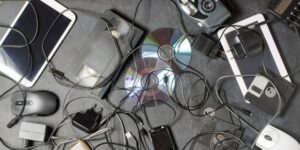Technology is a marvellous thing. Each year, innovation in electronics allows businesses and consumers alike to do more.
Laptops, smart phones, and servers all get faster. Data storage becomes smaller, faster, and cheaper. What was cutting edge yesterday is seemingly legacy a few minutes later. Every year an estimated 2 million tonnes of electronic items are discarded by households and businesses in the UK! What happens to all the old electronics?
Learn more: Recycling WEEE Services.
Not that long ago, landfill was the destination of choice for end-of-life technology, and for some unfortunate cryptocurrency owners, that still seems to be the case. However not only does landfill take up a huge amount of space, but there is also a significant environmental impact of electrical and electronic items releasing harmful toxins into the water table and air. In 2002, these environmental issues caused by electrical and electronic waste were addressed, and the first draft of the WEEE Directive was introduced.
Waste Electrical and Electronic Equipment (WEEE)
The current rules are the Waste Electric and Electronic Equipment (WEEE) Regulations 2013 which became law in the UK on the 1st of January 2014. Since the original EU legislation was passed into UK law, there have been updates to clarify and broaden the scope of electrical items included and to deal with Brexit. In 2019, the Open Scope amendment meant that all electrical items were now in scope, irrespective of the need to fit into an exact product category.
What is the scope of WEEE?
According to the UK Health and Safety Executive (HSE), the scope of WEEE includes most products that have a plug or need a battery. There are fourteen broad categories of electronics outlined in the WEEE regulations:
- Large household appliances
- Small household appliances
- IT and telecommunications equipment
- Consumer equipment
- Lighting equipment
- Electrical and electronic tools
- Toys, leisure, and sports equipment machines
- Medical devices
- Monitoring and control equipment
- Automatic dispensers
- Display equipment
- Cooling equipment
- Gas discharge lamps, including LED lighting
- Photovoltaic (Solar) Panels
Since the 2019 Open Scope amendment, those responsible for the implementation of the WEEE directives, need to find the best fit amongst these categories, as opposed to arguing that the regulations do not apply to their ‘unique’ electronic offering.
There are some electronics which the regulations do not apply to, such as products for military use, implantable medical devices and indeed equipment designed to be sent into space!
Whilst it is the IT and telecommunications equipment category that will most concern the IT channel, display equipment, cooling and monitoring electronics are likely to fall into other groups.


Who is responsible for recycling under WEEE?
The WEEE Regulations are designed in part to reduce the amount of electronics that goes to landfill. This is achieved by placing a responsibility on producers and ‘distributors’ of electrical and electronic equipment to finance the collection, treatment, and recovery of WEEE.
Business and other users, such as schools and hospitals, have a responsibility to ensure their treatment of end-of-use electronics is disposed of, in a manner compatible with the WEEE regulations.
Consumers and householders also have a duty to dispose of their electrical waste correctly, either via a local recycling centre or taking the unwanted product back to an appropriate retailer.
You may be confused by the use of the word ‘distributor’ in the WEEE regulations? To be clear, it does not correspond directly with the common IT channel usage! The term is used to denote the party that sold the equipment, irrespective of selling technique. This is to help distinguish between an end user or the Original Equipment Manufacturer (OEM). Under WEEE, a VAR is potentially a ‘distributor’!
WEEE and the Channel
Whilst all OEMs have a WEEE responsibility as a manufacturer, it is less clear for other channel participants. WEEE regulations distinguish between Business-to-Consumer (B2C) and Business-to-Business (B2B) products and routes. For B2B sales, the ‘seller’ is not responsible for implementing WEEE, for B2C sales, they are.
Where a product, such as a laptop, could be bought by a non-business end-user, then the product is classified as B2C for all sales, including those to businesses.
Where a distribution channel is only available to non-households, you can classify a product as B2B only if the product is designed solely for business use. So, a VAR selling a laptop to a business, will be responsible for WEEE, if the same laptop could be bought by a non-business.
If all of this is confusing, then take a step back. Perhaps one of the biggest impacts of WEEE is a change in what customers are now asking for. Every tender is likely to include a section on how the seller is ensuring that WEEE regulations are met, and additionally what is being done to ensure a minimised environmental impact through appropriate recycling.
In short, everyone in the channel has a part to play in WEEE, even though the exact role will vary by product and customer type.
How can SCT help with WEEE?
SCT engages with specialist suppliers for the recycling and disposal of WEEE, and other controlled waste, and the restriction of hazardous substances (RoHS). This ensures full compliance with government waste guidelines, including tracking and certification documentation which demonstrates conformity. We also provide a secure data wiping service, ensuring that all products are handled by security-cleared engineers who follow a strict security-audited, step-by-step process.
If you would like to find out more about what we do, then please don’t hesitate to get in touch.